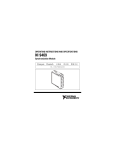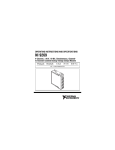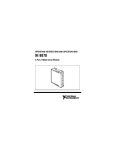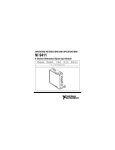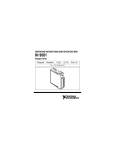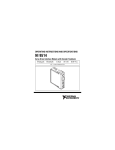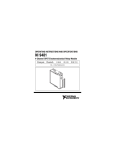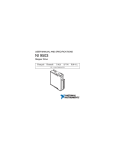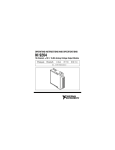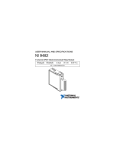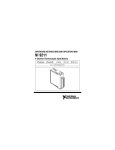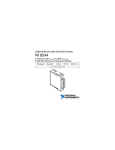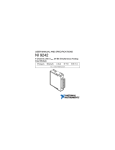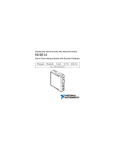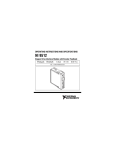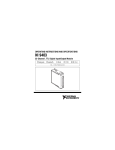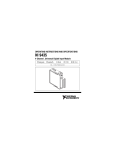Download NI 9467 Operating Instructions and Specifications
Transcript
OPERATING INSTRUCTIONS AND SPECIFICATIONS NI 9467 C Series GPS Synchronization Module Français Deutsch ni.com/manuals This document describes how to use the NI 9467 and includes specifications. Visit ni.com/info and enter rdsoftwareversion to determine which software you need for the modules you are using. For information about installing, configuring, and programming the system, refer to the system documentation. Visit ni.com/info and enter cseriesdoc for information about C Series documentation. Note The safety guidelines and specifications in this document are specific to the NI 9467. The other components in the system might not meet the same safety ratings and specifications. Refer to the documentation for each component in the system to determine the safety ratings and specifications for the entire system. Visit ni.com/info and enter cseriesdoc for information about C Series documentation. Safety Guidelines Caution Do not operate the NI 9467 in a manner not specified in the user manual or operating instructions. Product misuse can result in a hazard. You can compromise the safety protection built into the product if the product is damaged in any way. If the product is damaged, return it to National Instruments for repair. NI 9467 Operating Instructions and Specifications 2 ni.com This icon denotes that the component may be hot. Touching this component may result in bodily injury. Hot Surface Safety Guidelines for Hazardous Locations The NI 9467 is suitable for use in Class I, Division 2, Groups A, B, C, D, T4 hazardous locations; Class I, Zone 2, AEx nA IIC T4, and Ex nA IIC T4 hazardous locations; and nonhazardous locations only. Follow these guidelines if you are installing the NI 9467 in a potentially explosive environment. Not following these guidelines may result in serious injury or death. Caution Do not disconnect I/O-side wires or connectors unless power has been switched off or the area is known to be nonhazardous. Do not remove modules unless power has been switched off or the area is known to be nonhazardous. Caution Substitution of components may impair suitability for Class I, Division 2. Caution For Division 2 and Zone 2 applications, install the system in an enclosure rated to at least IP 54 as defined by IEC 60529 and EN 60529. Caution © National Instruments 3 NI 9467 Operating Instructions and Specifications Special Conditions for Hazardous Locations Use in Europe This equipment has been evaluated as Ex nA IIC T4 equipment under DEMKO Certificate No. 07 ATEX 0626664X. Each module is marked II 3G and is suitable for use in Zone 2 hazardous locations, in ambient temperatures of –40 °C ≤ Ta ≤ 70 °C. If you are using the NI 9467 in Gas Group IIC hazardous locations, you must use the device in an NI chassis that has been evaluated as Ex nC IIC T4, EEx nC IIC T4, Ex nA IIC T4, or Ex nL IIC T4 equipment. Electromagnetic Compatibility Guidelines This product was tested and complies with the regulatory requirements and limits for electromagnetic compatibility (EMC) stated in the product specifications. These requirements and limits provide reasonable protection against harmful interference when the product is operated in the intended operational electromagnetic environment. This product is intended for use in industrial locations. However, harmful interference may occur in some installations, when the product is connected to a peripheral device or test object, or if the product is used in residential or commercial areas. To minimize interference with radio and television reception and prevent NI 9467 Operating Instructions and Specifications 4 ni.com unacceptable performance degradation, install and use this product in strict accordance with the instructions in the product documentation. Furthermore, any modifications to the product not expressly approved by National Instruments could void your authority to operate it under your local regulatory rules. To ensure the specified EMC performance, operate this product only with shielded cables and accessories. Caution Special Conditions for Marine Applications Some products are Lloyd’s Register (LR) Type Approved for marine (shipboard) applications. To verify Lloyd’s Register certification for a product, visit ni.com/certification and search for the LR certificate, or look for the Lloyd’s Register mark on the product label. In order to meet the EMC requirements for marine applications, install the product in a shielded enclosure with shielded and/or filtered power and input/output ports. In addition, take precautions when Caution © National Instruments 5 NI 9467 Operating Instructions and Specifications designing, selecting, and installing measurement probes and cables to ensure that the desired EMC performance is attained. Overview of the NI 9467 The NI 9467 is a stationary GPS timing module for C Series platforms. It provides accurate timing and geographic location information to the C Series host, which enables synchronization of C Series systems. At start-up, the NI 9467 automatically begins determining its location through a process known as self-survey. During the self-survey, the module computes a location fix every second and averages the locations at the end to obtain a more accurate location. After the self-survey, the NI 9467 no longer computes new location fixes; it uses its known location and satellite signals to generate accurate timing signals. Start-Up Behavior Like all GPS receivers, the NI 9467 requires GPS satellite ephemeris and almanac data to compute accurate time and location. The ephemeris is detailed orbital information about each NI 9467 Operating Instructions and Specifications 6 ni.com satellite (where each satellite is expected to be at a given time). The almanac data describes the general health of each satellite (for example, the receiver must not use signals from satellites marked as unhealthy) and contains coarse orbit information. The GPS satellites broadcast the ephemeris and almanac data every 30 seconds. Therefore, it usually takes approximately 30 seconds for it to receive the ephemeris and almanac data and start computing location and timing fixes. Status LED The NI 9467 has a front panel LED to indicate status. The following table describes the meaning of each LED pattern. Conditions LED state Normal operation Solid green Performing survey Blinking green Not enough or no satellites Blinking yellow Antenna error (no antenna or over-current) Solid yellow Unconfigured Off © National Instruments 7 NI 9467 Operating Instructions and Specifications Although the module may not detect the presence of very low-power GPS antennas, it can still function correctly. Note that the LED and software may report antenna error under these conditions, and if the current consumed is close to the detection threshold the LED may flicker. Refer to the Specifications section for more details. Note Connecting the NI 9467 The NI 9467 has one SMA female connector on its front panel for a GPS active antenna. The connector provides a DC voltage to power the antenna and also serves as input for the GPS RF signal. Antenna Installation National Instruments recommends using a lightning arrester in line with the GPS antenna installation to protect the NI 9467 and the C Series system from possible damage and operators from injury in the event of lightning. Caution The embedded GPS receiver in the NI 9467 requires signals from several satellites to compute accurate timing and location. The NI 9467 Operating Instructions and Specifications 8 ni.com more satellites available to the receiver, the more accurately it can determine time and location. Therefore, the antenna location should be such that it receives signals from the greatest number of satellites possible. As the number of satellites visible to the antenna decreases, the synchronization performance may also decrease. Choose the antenna location so that the antenna has a clear view of the sky. There is no strict definition for a clear view of the sky, but a suitable guideline is that the GPS antenna should have a straight line of sight to the sky in all directions (360°) down to an imaginary line making a 30° angle with the ground. Locations far from trees and tall buildings that could block or reflect GPS satellite signals are best. Maximum Cable Length Maximum cable length depends on the GPS antenna gain and the cable’s loss per unit of distance. National Instruments recommends a GPS signal strength of between –135 dBm and –120 dBm at the NI 9467 SMA input. GPS signal strength on the Earth’s surface is typically –130 dBm. Targeting a signal strength of –125 dBm at the SMA input, you can compute the maximum cable length as: Max_cable_loss = –130 dBm + antenna_gain – (–125 dBm) Max_cable_length = Max_cable_loss / (loss_per_unit_of_distance) © National Instruments 9 NI 9467 Operating Instructions and Specifications For example, if you use an active antenna with gain of 28 dB and RG-58 cable, which has a rated loss at 1.5 GHz of about 0.8 dB/m (24.5 dB/100 ft), the maximum cable length you could use is: Max_cable_loss = –130 dBm + 28 dB – (–125 dBm) = 23 dB Max_cable_length = 23 dB / (0.8 dB/m) ≈ 29 m Sleep Mode This module supports a low-power sleep mode. Support for sleep mode at the system level depends on the chassis that the module is plugged into. Refer to the chassis manual for information about support for sleep mode. If the chassis supports sleep mode, refer to the software help for information about enabling sleep mode. Visit ni.com/info and enter cseriesdoc for information about C Series documentation. Typically, when a system is in sleep mode, you cannot communicate with the modules. In sleep mode, the system consumes minimal power and may dissipate less heat than it does in normal mode. Refer to the Specifications section for more information about power consumption and thermal dissipation. NI 9467 Operating Instructions and Specifications 10 ni.com Note that when the NI 9467 is in sleep mode, the GPS receiver is not powered and stops tracking satellites. When the module exits sleep mode and power to the GPS receiver is restored, the module goes through the normal power-up process, which includes the ephemeris/almanac data acquisition and self-survey process. Therefore, it can take approximately 30 seconds before usable timing and location signaling can be generated. Refer to Start-Up Behavior for more information. © National Instruments 11 NI 9467 Operating Instructions and Specifications Specifications General Characteristics Signal type ........................................ L1 frequency; GPS C/A code Datum ............................................... WGS-84 RF GPS signal frequency.................. 1575.42 MHz Recommended signal strength at SMA1 ............................................ –135 dBm to –120 dBm Max RF power at input ..................... 3 dBm Input impedance................................ 50 Ω, nominal MTBF ............................................... 2,234,702 h PPS accuracy2 ................................... ±100 ns, > 99% typical 1 Higher signal strength might saturate the receiver and degrade performance. 2 For the best timing accuracy performance, ensure that the GPS antenna has a clear view of the sky. Refer to the Antenna Installation section for more details. NI 9467 Operating Instructions and Specifications 12 ni.com GPS Antenna Connector Characteristics GPS antenna connector type............. SMA female DC voltage output for active antenna.............................. +5 V ± 10% Max. current output .......................... 30 mA Minimum current for antenna presence detection............................. 6 mA typical, 9.5 mA max Over-voltage protection .................... ± 30 VDC Power Requirements Power consumption from chassis Active mode ............................... 150 mA max Sleep mode ................................. 1 mA Thermal dissipation (at 70°C) Active mode ............................... 550 mW max Sleep mode ................................. 5 mW Physical Characteristics Weight............................................... 141 g © National Instruments 13 NI 9467 Operating Instructions and Specifications Environmental Refer to the manual for the chassis you are using for more information about meeting these specifications. Operating temperature (IEC 60068-2-1, IEC 60068-2-2) ..... –40 to 70 °C Storage temperature (IEC 60068-2-1, IEC 60068-2-2) ..... –40 to 85 °C Ingress protection.............................. IP 40 Operating humidity (IEC 60068-2-56).............................. 10 to 90% RH, noncondensing Storage humidity (IEC 60068-2-56).............................. 5 to 95% RH, noncondensing Pollution Degree (IEC 60664) .......... 2 Maximum altitude............................. 5000 m Indoor use only. NI 9467 Operating Instructions and Specifications 14 ni.com Shock and Vibration To meet these specifications, you must panel mount the system. Operating vibration Random (IEC 60068-2-64)......... 5 grms, 10 to 500 Hz Sinusoidal (IEC 60068-2-6) ....... 5 g, 10 to 500 Hz Operating shock (IEC 60068-2-27).............................. 30 g, 11 ms half sine, 50 g, 3 ms half sine, 18 shocks at 6 orientations Safety The NI 9467 module does not provide electrical isolation. Note Safety Standards This product meets the requirements of the following standards of safety for electrical equipment for measurement, control, and laboratory use: • IEC 61010-1, EN 61010-1 • UL 61010-1, CSA 61010-1 © National Instruments 15 NI 9467 Operating Instructions and Specifications Note For UL and other safety certifications, refer to the product label or the Online Product Certification section. Hazardous Locations U.S. (UL) .......................................... Class I, Division 2, Groups A, B, C, D, T4; Class I, Zone 2, AEx nA IIC T4 Canada (C-UL) ................................. Class I, Division 2, Groups A, B, C, D, T4; Class I, Zone 2, Ex nA IIC T4 Europe (DEMKO)............................. Ex nA IIC T4 Electromagnetic Compatibility This product meets the requirements of the following EMC standards for electrical equipment for measurement, control, and laboratory use: • EN 61326-1 (IEC 61326-1): Class A emissions; Industrial immunity • EN 55011 (CISPR 11): Group 1, Class A emissions NI 9467 Operating Instructions and Specifications 16 ni.com • AS/NZS CISPR 11: Group 1, Class A emissions • FCC 47 CFR Part 15B: Class A emissions • ICES-001: Class A emissions Note In the United States (per FCC 47 CFR), Class A equipment is intended for use in commercial, light-industrial, and heavy-industrial locations. In Europe, Canada, Australia and New Zealand (per CISPR 11) Class A equipment is intended for use only in heavy-industrial locations. Note Group 1 equipment (per CISPR 11) is any industrial, scientific, or medical equipment that does not intentionally generate radio frequency energy for the treatment of material or inspection/analysis purposes. Note For EMC declarations and certifications, and additional information, refer to the Online Product Certification section. © National Instruments 17 NI 9467 Operating Instructions and Specifications CE Compliance This product meets the essential requirements of applicable European Directives as follows: • 2006/95/EC; Low-Voltage Directive (safety) • 2004/108/EC; Electromagnetic Compatibility Directive (EMC) Online Product Certification Refer to the product Declaration of Conformity (DoC) for additional regulatory compliance information. To obtain product certifications and the DoC for this product, visit ni.com/ certification, search by model number or product line, and click the appropriate link in the Certification column. Environmental Management NI is committed to designing and manufacturing products in an environmentally responsible manner. NI recognizes that eliminating certain hazardous substances from our products is beneficial to the environment and to NI customers. NI 9467 Operating Instructions and Specifications 18 ni.com For additional environmental information, refer to the NI and the Environment Web page at ni.com/environment. This page contains the environmental regulations and directives with which NI complies, as well as other environmental information not included in this document. Waste Electrical and Electronic Equipment (WEEE) EU Customers At the end of the product life cycle, all products must be sent to a WEEE recycling center. For more information about WEEE recycling centers, National Instruments WEEE initiatives, and compliance with WEEE Directive 2002/96/EC on Waste and Electronic Equipment, visit ni.com/ environment/weee. ⬉ᄤֵᙃѻક∵ᶧࠊㅵ⧚ࡲ⊩ ˄Ё RoHS˅ Ёᅶ᠋ National Instruments ヺড়Ё⬉ᄤֵᙃ ѻકЁ䰤ࠊՓ⫼ᶤѯ᳝ᆇ⠽䋼ᣛҸ (RoHS)DŽ݇Ѣ National Instruments Ё RoHS ড়㾘ᗻֵᙃˈ䇋ⱏᔩ ni.com/environment/rohs_chinaDŽ (For information about China RoHS compliance, go to ni.com/ environment/rohs_china.) © National Instruments 19 NI 9467 Operating Instructions and Specifications Where to Go for Support The National Instruments Web site is your complete resource for technical support. At ni.com/support you have access to everything from troubleshooting and application development self-help resources to email and phone assistance from NI Application Engineers. National Instruments corporate headquarters is located at 11500 North Mopac Expressway, Austin, Texas, 78759-3504. National Instruments also has offices located around the world to help address your support needs. For telephone support in the United States, create your service request at ni.com/support and follow the calling instructions or dial 512 795 8248. For telephone support outside the United States, visit the Worldwide Offices section of ni.com/niglobal to access the branch office Web sites, which provide up-to-date contact information, support phone numbers, email addresses, and current events. LabVIEW, National Instruments, NI, ni.com, the National Instruments corporate logo, and the Eagle logo are trademarks of National Instruments Corporation. Refer to the Trademark Information at ni.com/trademarks for other National Instruments trademarks. Other product and company names mentioned herein are trademarks or trade names of their respective companies. For patents covering National Instruments products/technology, refer to the appropriate location: Help»Patents in your software, the patents.txt file on your media, or the National Instruments Patent Notice at ni.com/patents. Refer to the Export Compliance Information at ni.com/legal/export-compliance for the National Instruments global trade compliance policy and how to obtain relevant HTS codes, ECCNs, and other import/export data. © 2012 National Instruments Corp. All rights reserved. 373230A-01 Jun12




















